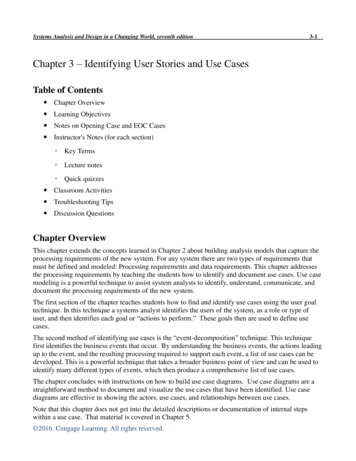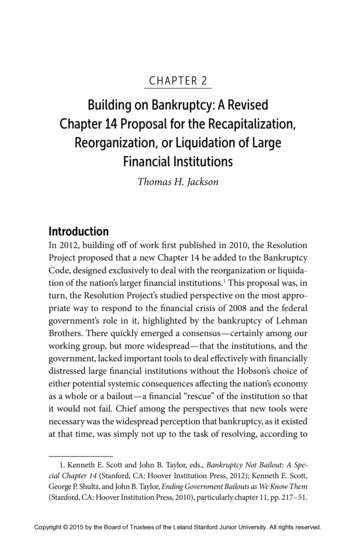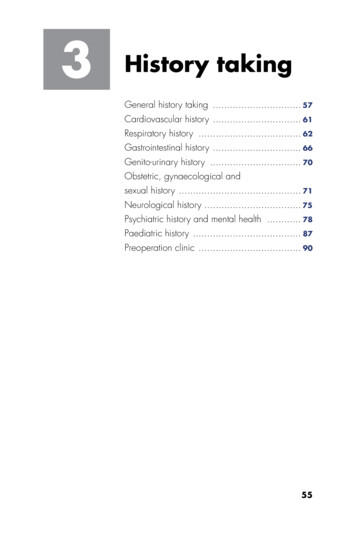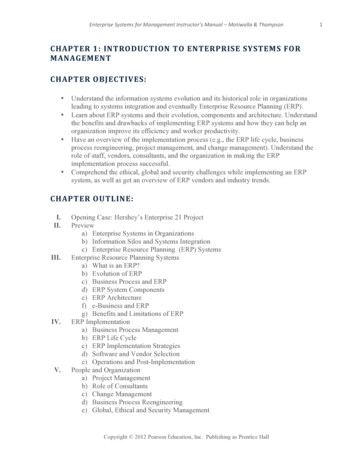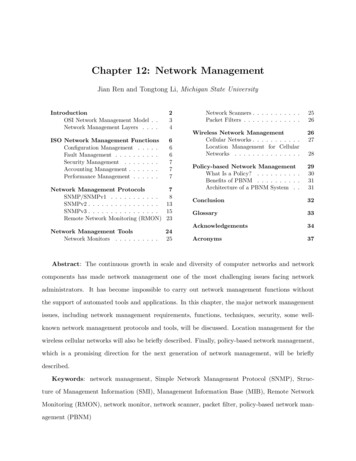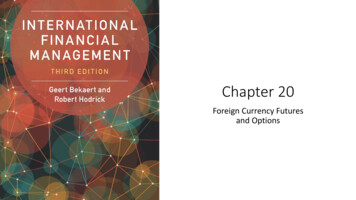
Transcription
Chapter 20Foreign Currency Futuresand Options 2018 Cambridge University Press20-1
20.1 The Basics of Futures Contracts Futures (versus forwards) Allow individuals and firms to buy and sell specific amounts of foreign currency at an agreedupon price determined on a given future day Traded on an exchange (e.g., CME Group, NYSE Euronex’s LIFFE CONNECT, and Tokyo FinancialExchange) Standardized, smaller amounts (e.g., 12.5M, 125,000, C 100,000) Fixed maturity dates Credit risk Futures brokerage firms register with the Commodity futures trading commission (CFTC) as afutures commission merchant (FCM) Clearing member / clearinghouse 2018 Cambridge University Press20-2
20.1 The Basics of Futures Contracts Margins Credit risk is handled by setting up an account called a margin account, wherein they deposit anasset as collateral The first asset is called the initial margin Asset can be cash, US government obligations, securities listed on NYSE and American Stock Exchange,gold warehouse receipts or letters of credit Depends on size of contract and variability of currency involved Margin call – when the value of the margin account reaches the maintenance margin, the account mustbe brought back up to its initial value Marking to market – deposit of daily losses/profits Maintenance margins Minimum amount that must be kept in the account to guard against severe fluctuations in the futuresprices (for CME, about 1,500 for USD/GBP and 4,500 for JPY/USD) 2018 Cambridge University Press20-3
Exhibit 20.1 An Exampleof Marking to Market inthe Futures Market Euro contract ( 125,000) ��𝐶𝐶𝐶 𝑆𝑆𝑆𝑆𝑆𝑆𝑆𝑆 𝐹𝐹Initial Margin – forboth buyer and sellerSettle PriceOn September 16, you “go long inDecember Euro” In other words, you buy a Euro contractthat is deliverable in December Maintenance margin: 1500Margin call 2018 Cambridge University Press20-4
20.1 The Basics of Futures Contracts The pricing of futures contracts The payoff on a forward contract: 𝑆𝑆(𝑇𝑇) 𝐹𝐹(𝑡𝑡) where 𝑆𝑆(𝑇𝑇) is the future spot rate at maturity time 𝑇𝑇 and 𝐹𝐹(𝑡𝑡) is the forward price at time 𝑡𝑡 The payoff on a futures contract 𝑓𝑓(𝑇𝑇) – 𝑓𝑓(𝑡𝑡) Where 𝑓𝑓(𝑇𝑇) is the futures price at maturity time 𝑇𝑇 and 𝑓𝑓(𝑡𝑡) is the futures price at time 𝑡𝑡 Payoffs for futures can differ than those from forwards because the interest that is earned onfuture profits or that must be paid on future losses in a futures contract 2018 Cambridge University Press20-5
Exhibit 20.2 FuturesQuotes fromAugust 5, 2015 2018 Cambridge University Press20-6
20.2 Hedging Transaction Risk with Futures It is mid-February and Nancy Foods expects a receivable of 250,000 in onemonth Will need 2 contracts (since contracts are 125,000) Wants to receive when the weakens to protect against a loss in receivable Thereby selling If contract delivery date coincides with receivable date, maturity is matched perfectly Example: February: Spot ( 1.24/ ); Future ( 1.23/ ) March: Spot ( 1.35/ ); Future ( 1.35/ ); 30-day i( ) 3% p.a. Receivable in 30 days 2018 Cambridge University Press20-7
20.2 Hedging Transaction Risk with Futures Value upon receipt of money (mid-March) Sell receivable in spot market in March 250,000 1.35/ 337,500 Loss on futures contract [( 1.23/ ) ( 1.35/ )] 250,000 30,000 Combination of CFs 337,500 30,000 307,500 Effective exchange rate 307,500/ 250,000 1.23/ 2018 Cambridge University Press20-8
20.2 Hedging Transaction Risk with Futures Potential problems with a futures hedge What if you need to hedge an odd amount? What if the contract delivery date does not match your receivable/payable date? 2018 Cambridge University Press20-9
20.3 Basics of Foreign Currency Option Contracts Gives the buyer the right but not the obligation to buy (call) or sell (put) a specific amount offoreign currency for domestic currency at a specific forex rate Price is called the premium Traded by money center banks and exchanges (e.g., NASDAQ, OMX, PHLX) European vs. American options: European options can only be exercised on maturity date; Americans can be exercised anytime (i.e., “earlyexercise” is permitted) Strike / exercise price (“K”) – forex rate in the contract Intrinsic value – revenue from exercising an option In the money / out of the money / at-the-money Call option: 𝑚𝑚𝑚𝑚𝑚𝑚[𝑆𝑆 𝐾𝐾, 0] Put option: 𝑚𝑚𝑚𝑚𝑚𝑚[𝐾𝐾 𝑆𝑆, 0] 2018 Cambridge University Press20-10
20.3 Basics of Foreign Currency Option ContractsExample: A Euro Call Option Against Dollars A particular euro call option offers the buyer the right (but not the obligation) topurchase 1M @ 1.20/ If the price of the K, owner will exercise the option at expiration date To exercise: the buyer pays ( 1.20/ ) 1𝑀𝑀 1.2𝑀𝑀 to the seller and the seller delivers the 1M The buyer can then turn around and sell the on the spot market at a higher price! For example, if the spot is 1.25/ , the revenue is: [( 1.25/ ) ( 1.20/ )] 1𝑀𝑀 50,000 This is the intrinsic value of the option, not the profit Buyer could therefore simply accept 50,000 from the seller if both parties prefer to do so 2018 Cambridge University Press20-11
20.3 Basics of Foreign Currency Option ContractsExample: A Yen Put Option Against the Pound A particular yen put option offers the buyer the right (but not the obligation) tosell 100M @ 0.6494/ 100 If the price of the 100 K, owner will exercise To exercise: the buyer delivers 100M to the seller The seller must pay ( 0.6494/ 100) 100𝑀𝑀 649,400 For example, say the spot at exercise is 0.6000/ 100 The revenue then is: [( 0.6494/ 100) ( 0.6000/ 100)] 100𝑀𝑀 49,400 Intrinsic value of option, not the profit Buyer could therefore accept 49,400 from seller if both of the parties prefer to do so 2018 Cambridge University Press20-12
20.3 Basics of Foreign Currency Option Contracts Options trading Mostly traded by banks in the interbank market or the OTC market Typically European convention in OTC market CFs either exchanged or cash settlement Considerable counterparty risk, managed by exposure limits Currency options on the NASDAQ OMX PHLX Mostly options on spot currencies vs U.S. Dollar Expiration months: March, June, September and December Two nearest future months Last trading day is the third Friday of expiring month European-exercise type but settlement is in dollars Options Clearing Corporation serves as clearinghouse 2018 Cambridge University Press20-13
Exhibit 20.4 Prices ofOptions on FuturesContracts 2018 Cambridge University Press20-14
20.3 Basics of Foreign Currency Option Contracts Currency options at the CME group Contract sizes and expiration months follow those of futures contracts Trading closes on Friday immediately preceding the third Wednesday of the contract month 2018 Cambridge University Press20-15
20.3 Basics of Foreign Currency Option Contracts Exchange-listed currency warrants Longer-maturity foreign currency options ( 1 year) Issued by major corporations Actively traded on exchanges such as the American Stock Exchange, London Stock Exchange, andAustralian Stock Exchange American-style option contracts Issuers include AT&T, Deutsche Bank, Ford, Goldman Sachs Not taking on currency risk – likely hedged in OTC market Buying an option at wholesale price and selling at retail price Allow retail investors and small corporations that are too small to participate in OTC market topurchase L/T currency options 2018 Cambridge University Press20-16
20.4 The Use of Options in Risk Management A bidding situation at Bagwell Construction U.S. company wants to bid on a building in Tokyo (in )Transaction risk since bid is in Cannot use forward hedge because if they do not win, it will be a liabilityOption allows flexibility in case they do not win Using options to hedge transaction risk Forward / futures contracts do not allow you to benefit from the “up” side Allows a hedge but maintains the upside potential from favorable exchange rate changes 2018 Cambridge University Press20-17
20.4 The Use of Options in Risk Management Pfimerc Today is Friday, 1st October 2010 Receivable of 500,000 on Friday, 19th March 2011 S: 1.5834/ 170-day F: 1.5805/ 170-day interest rate: 0.20% p.a. 34-day interest rate: 0.40% p.a.Option data for March contracts in / :StrikeCall PricePut Price1580.05000.04811590.04520.05331600.04080.0589 2018 Cambridge University Press20-18
20.4 The Use of Options in Risk Management How should Pfimerc hedge? put option: right (but not obligation) to sell at a specific price if the value of the falls In order to sell 500,000, Pfimerc must pay: 500,000 ( 0.0481/ ) 24,050 Exercise option if falls below 1.58/ : 500,000 1.58 790,000 if 𝑆𝑆(𝑡𝑡 170) 1.58/ Sell in spot market if is worth 1.58 in 170 days: 500,000 𝑆𝑆 𝑡𝑡 170 790,000 if 𝑆𝑆(𝑡𝑡 170) 1.58/ Either way, cost of the put is: [ 24,050 (1 (0.002 170/360))] 24,073 Minimum revenue is therefore: 790,000 24,073 765,927 2018 Cambridge University Press20-19
20.4 The Use of Options in Risk Management Options as insurance contracts Hedging foreign currency risk with forwards and options Options as insurance contracts As amount of coverage increases so does the cost (premium) to insure Changing the quality of the insurance policy Make ceiling on our cost of the foreign currency as low as possible 2018 Cambridge University Press20-20
Exhibit 20.7 Hedging and Speculating Strategies 2018 Cambridge University Press20-21
20.4 The Use of Options in Risk Management Option valuation – Black and Scholes (1973) The intrinsic value of an option If the owner exercises it, will it make money (in / at / out of the money)? The time value of an option The part of the option’s value that is attributed to the time left to expiry Time value Option price – intrinsic value Increasing the exercise price (call) Reduced the probability that the option will be exercised so it decreases the option’s value 2018 Cambridge University Press20-22
20.4 The Use of Options in Risk Management An increase in the variance The distribution with the larger variance yields possibly larger payoffs so it increase the value ofthe option Increasing the time to expiration American – increases uncertainty of spot rate at maturity so it increases the option’s value European – generally increases the option’s value but it depends because in-the-money Europeanoptions can lose value as time evolves 2018 Cambridge University Press20-23
Exhibit 20.10 DifferentProbability Distributionsof Future USD/EUR 2018 Cambridge University Press20-24
Exhibit 20.11 DifferentProbability Distributionsof Future USD/EUR 2018 Cambridge University Press20-25
20.5 Combinations of Options and Exotic Options Exotic options Options with different payoff patterns than basic options Range forward contract Allows a company to specify a range of future spot rates over which the firm can sell or buy forex at thefuture spot rate No money up front Cylinder options Allows buyers to specify a desired trading range and either pay money or potentially receive money upfront for entering into the contracts Both can be synthesized Buying a call and selling a put (at a lower K) For range forward contract: K must be set such that 𝑃𝑃(𝐾𝐾𝑝𝑝 ) 𝐶𝐶(𝐾𝐾𝑐𝑐 ) 2018 Cambridge University Press20-26
20.5 Combinations of Options and Exotic Options Average-rate options (or “Asian” option) Most common exotic option Payoff is 𝑚𝑚𝑚𝑚𝑚𝑚[0, Ŝ – 𝐾𝐾] Ŝ defines the average forex rate between the initiation of the contract and the expiration date (source andtime interval are agreed upon) Barrier options Regular option with additional requirement that either activates or extinguishes the option if abarrier forex rate is reached Lookback options Option that allows you to buy/sell at least/most expensive prices over a year (more expensive thanregular options) Digital options (“binary” options) Pays off principal if K is reached and 0 otherwise 2018 Cambridge University Press20-27
An example of option pricing Suppose that we want to buy a call option that allows us to buy euros threemonths from now at a price of 1.14. Suppose there are only two possible values of the euro three months from now –either 1.16 or 1.13. Suppose the 3-month interest rate in the U.S. is 0.01 (not annualized), and inEurope is 0.005 Suppose the current spot exchange rates is 1.15 I am going to build a portfolio that replicates the payoffs to the option, and thenfigure out what that portfolio costs. 2018 Cambridge University Press20-28
Replicating portfolio I will buy X, and borrow Y. The idea is that I am going to find an X and Y that willgive me a payoff equal to that of the call option that lets me buys euros for 1.14 This portfolio I buy today has a cost C given by C ( 1.15 X) - Y Now, if I bought the call option, it has two possible payoffs. Suppose the calloption allows me to buy 100 at the price 1.14. If the spot price of euros in 3 months turns out to be 1.13, the call option is worthless. If the spot price of euros in 3 months is 1.16, the value of the call option is( 1.16 - 1.14) 100 2.00 Now we want to see what values of X and Y will give us payoff of 2.00 when thespot exchange rate is 1.16, and 0 when the spot exchange rate is 1.13 2018 Cambridge University Press20-29
Pricing the option The value of my portfolio in one month is( S X)(1.02) - Y(1.01), where S is the spot exchange rate in one month. We are looking for the values of X and Y that satisfy these two equations:( 1.13 X)(1.005) - Y(1.01) 0( 1.16 X)(1.005) - Y(1.01) 2.00 These are two linear equations in two variables, X and Y, which we can solve We find X
foreign currency for domestic currency at a specific forex rate Price is called the premium Traded by money center banks and exchanges (e.g., NASDAQ, OMX, PHLX) European vs. American options: European options can only be exercised on maturity date; Americans can be exercised anytime (i.e., “early exercise” is permitted)





